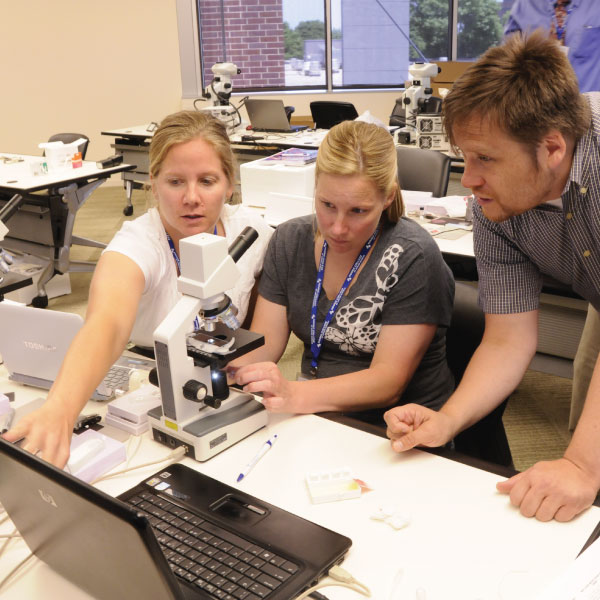
Education: Helping Teachers Use Microscopy to Engage Students in Science
At a Glance
Since 2008, Hooke College of Applied Sciences, a member of The McCrone Group, has offered workshops to teachers, giving instruction in using microscopes to engage their students in science.
Situation
American students continue to lag behind other first-world countries in science and math achievement, dropping to the middle of the pack in K-12 science education for more than a decade. Donald Brooks, President and CEO of The McCrone Group, believed that showing students the world through the lens of a microscope was one way for teachers to get students excited about science.
Issue
Unfortunately, for many middle school and high school teachers, microscopy is often overlooked or seen as too difficult to use and teach. Microscopes are also incorrectly designated as a biology tool, when, in fact many scientific disciplines – ranging from art conservation to food contamination – require a strong understanding of these “magic lenses.” The successful implementation of microscopes in the classroom calls for a knowledge set and expertise of the scientific tool that many teachers lack. As a result, microscopes are rarely incorporated into the curriculum past the apparatus’ basic functions.
Solution
Brooks believed that science education was greatly in need of some inspiration and innovation. His desire to give back to the community and contribute to raising the level of science and math achievement in the US led to the creation of Hooke College of Applied Sciences’ first Microscopy Workshop for Middle School and High School Science Teachers.
The scientific staff of The McCrone Group joined forces with several hand-picked award-winning middle school and high school science teachers. Together, they developed the unique course that Brooks had envisioned.
First held in the summer of 2008, the weeklong workshop is designed to make teachers more proficient in microscopy and equip them with the know-how to immediately apply microscope-based lessons in the classroom.
“Before microscopes can be used in the classroom, educators must first be able to understand them,” said Tom Schaefer, workshop instructor and biology teacher at Waukesha West High School, Wisconsin.
Teachers who attend the weeklong camp are given a free Motic compound microscope with a built-in digital camera and archiving software for their classrooms. The McCrone Group provides teachers with state-of-the-art microscopy equipment, valued at more than $500, and supplemental resources that many classrooms lack.
Students work through a custom manual developed by The McCrone Group’s John Gustav Delly titled “How to Use the Microscope.” Led by McCrone Associates scientists, the workshop gives teachers an opportunity to work closely with experts in the field of microscopy. “I couldn’t have asked for better instructors,” said Sarah Anderson, chemistry teacher at Lane Tech High School, Chicago, Illinois. “The McCrone Associates instructors are all extremely knowledgeable, easy to talk to and helpful. This is honestly one of the best classes I’ve taken.”
Under the guidance of instructors, some with more than 37 years of experience, teachers are led through approximately 40 hands-on experiments. Making the experience even more worthwhile, teachers who successfully complete the course are eligible to receive Illinois Continuing Professional Development Units (CPDUs) administered through the Illinois State Board of Education. Concordia Chicago University also accepts the course for 3 graduate credits for those who apply.
Results
For most teachers the workshop is an eye opening experience, showing them that microscopy can provide enrichment well beyond its usual microscope week relegation.
Even those who are familiar with microscopy discover that there is much more to learn from the experts at The McCrone Group. “Most science teachers are not well versed on microscopes, even those teaching microscopy,” said Schaefer. “I felt I still had a lot to learn after only a few minutes with McCrone’s instructors, and I’ve been working with microscopes for the past 20 years.”
The workshop shows teachers that microscopy can be applied to many other disciplines, from earth science to physics, chemistry to forensics. Many science teachers who specialize in subjects outside of biology tend to shy away from microscopy, believing that the microscope is strictly a biological tool.
“I didn’t realize that you could do all this with a microscope,” said Anderson. “I can talk about crystalline structures and compounds in class, but actually seeing that in the microscope versus seeing it in a PowerPoint presentation is very different. It’s not quite the same as seeing it right under your nose.”
The main purpose of the workshop is not only to educate the teachers but to also encourage classroom implementation. Teachers complete the workshop with the knowledge, techniques and experiments necessary to successfully bring microscopy to the classroom.
“By showing students the thousands of tiny organisms in water or the hairs of different animals, there is a ‘wow!’ factor there that cannot be achieved from a text book,” said Phil Sumidi, workshop instructor and science teacher at Maine West High School, Des Plaines, Illinois.
This sort of hands-on education is at the core of Hooke College of Applied Sciences. The McCrone Group believes that it is an aspect of education that plays an important role in teaching students of all ages real world techniques.